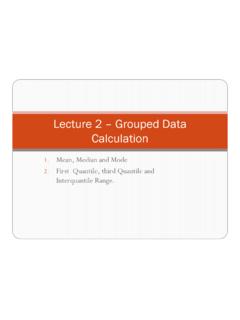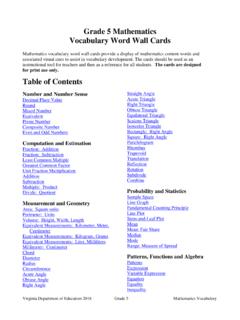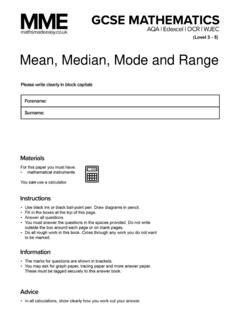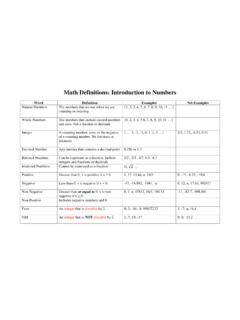Transcription of Hardin Middle School Math Cheat Sheets
1 name : _____ 7th Grade Math Teacher: _____ 8th Grade Math Teacher: _____ Hardin Middle School Math Cheat Sheets You will be given only one of these books. If you lose the book, it will cost $5 to replace it. Compiled by Shirk &Harrigan - Updated May 2013 Alphabetized Topics Pages Pages Area 32 Place Value 9, 10 Circumference 32 Properties 12 Comparing 23, 26 Proportions 22, 23, 24, 25, 26 Congruent Figures 35 Pythagorean Theorem 36 Converting 14, 15, 23 41 Divisibility Rules 8 Range 11 Equations 37, 38, 39 Rates 25 Flow Charts Ratios 25, 26 Formulas 32, 33, 34 Rounding 10 Fractions 18, 19, 20, 21, 22, 23, 24 Scale Factor 35 Geometric Figures 30, 31 Similar Figures 35 Greatest Common Factor (GF or GCD)
2 22 Slide Method 22 Inequalities 40 Substitution 29 Integers 18, 19 Surface Area 33 Ladder Method 22 Symbols 5 Least Common Multiple (LCM or LCD) 22 Triangles 30, 36 Mean 11 Variables 29 median 11 Vocabulary Words 43 Mode 11 Volume 34 Multiplication Table 6 Word Problems 41, 42 Order of Operations 16, 17 Percent 23, 24, 25, 26 Perimeter 32 3 Table of Contents Pages Cheat Sheets 5 42 Math Symbols 5 Multiplication Table 6 Types of Numbers 7 Divisibility Rules 8 Place Value 9 Rounding & Comparing 10 Measures of Central Tendency 11 Properties 12 Coordinate Graphing 13 Measurement Conversions 14 Metric Conversions 15 Order of Operations 16 17 Integers 18 19 Fraction Operations 20 21 Ladder/Slide Method 22 Converting Fractions, Decimals, & Percents 23 Cross Products 24 Ratios, Rates, & Proportions 25 Comparing with Ratios, Percents.
3 And Proportions 26 Solving Percent Problems 27 28 Substitution & Variables 29 Geometric Figures 30 31 Area, Perimeter, Circumference 32 Surface Area 33 Volume 34 Congruent & Similar Figures 35 Pythagorean Theorem 36 Hands-On-Equation 37 Understanding Flow Charts 38 Solving Equations Mathematically 39 Inequalities 40 Answering Questions 41 Word Problem Cheat Sheet 42 Math Vocabulary 43 - End 4 5 Mathematic Symbols Cheat Sheet + Plus or Positive Line AS Minus or Negative Line segment AS * x Multiplied by Ray AS / Divided by Triangle ABC = Equal to Angle ABC NOT equal Angle B Approximately equal to Right angle Congruent to Perpendicular to < Is less than Perpendicular to > Is Greater than % Degree Percent Is greater than or equal to Sum Square root of x Is less than or equal to Pi ( ) a/b a.
4 B Ratio of a to be or a divided by b or the fraction a/b ! xn Factorial Nth power of x (a, b) Ordered pair Infinity 6 7 Types of Numbers Cheat Sheet Prime Number A number that has exactly two (2) factors Zero (0) and One (1) are neither prime nor composite because they only have one factor (itself) Composite Number A number that has three (3) or more factors Even Numbers ending in 0, 2, 4, 6, 8 Odd Numbers ending in 1, 3, 5, 7, or 9 8 Divisibility Rules - Divisible by 2 All even numbers are divisible by 2. Even numbers end in 0, 2, 4, 6, or 8 and all are divisible by 2. - Divisible by 3 If the sum of the digits is divisible by 3 so is the number. Add up the digits in the number, if the answer is divisible by 3 so is the number. - Divisible by 4 Odd numbers are NEVER divisible by 4.
5 Odd numbers end in 1, 3, 5, 7, or 9, so any number ending with one of this will NOT be divisible by 4. Even numbers MAY be divisible by 4. To check, look at the last 2 digits of the number. If the number formed by the last 2 digits is divisible by 4, then the number is divisible by 4. - Divisible by 5 If a number ends in a 5 or a zero then it is divisible by 5 - Divisible by 6 If a number is divisible by 2 AND 3, it is divisible by 6. - Divisible by 9 If the sum of the digits is divisible by 9 so is the number. Add up the digits in the number, if the answer is divisible by 9 so is the number. - Divisible by 10 Numbers that are divisible by 10 end in with a zero. 9 Place Value Cheat Sheet From Billions to Ten-millionths 10 Place Value & Rounding Comparing & Ordering Decimals Rounding Rules Example Example 1.
6 Underline the determined value 2. Draw an arrow to number to the right of underlined number 3. 0 4 = Round Down (Keep the underline number the same) a. All numbers to the left of underlined number stay the same b. Underlined number stays the same c. All numbers to the right of underlined number go to zero 4. 5 9 = Round Up (Underline number goes up 1) a. All numbers to the left of the underline number stay the same b. Underline number goes up 1 c. All numbers to the right of underlined number go to zero Round Down Round Up Comparing Decimal Rules 1. Line up the decimals using their decimal point ** If you do not see a decimal point, it is at the end of the number Example = 423 = 2. Fill in zeros so that all numbers have the same place value 3. Compare each number in their lanes (from left to right) 4.
7 Determine greatest to least or least to greatest Billions Millions Thousand Ones . Decimals Hundred Billion Ten-Billions Billions Hundred-Millions Ten-Millions Millions Hundred-Thousand Ten-Thousands Thousands Hundreds Tens Ones . Tenths Hundredths Thousandths Ten-Thousandths Hundred-Thousandths Millionths .. 11 Measures of Central Tendency: The Mean, median , Mode, and Range When finding the measures of central tendency the first step is to place the numbers in order from least to greatest. Mean (Average): Add up a list of values in a set of data and divide by the number of values you have. 6, 4, 4, 3, 8 Step 1 Put in order from least to greatest 3, 4, 4, 6, 8 Step 2 Add up all the numbers 3 + 4 + 4 + 6 + 8 = 25 Step 3 Divide by the number of values you have 25 5 = 5 Answer The mean is 5 median ( Middle ): The Middle value in a set of data when the values are written in order.
8 If there are 2 values in the Middle , find the mean of the two. 6, 4, 4, 3, 8 Step 1 Put in order from least to greatest 3, 4, 4, 6, 8 Step 2 Find the Middle number **If there are an odd number of data values 3, 4, 4, 6, 8 Answer The median is 4 6, 4, 4, 3, 8, 5 Step 1 Put in order from least to greatest 3, 4, 4, 5, 6, 8 Step 2 Find the Middle number **If there are an even number of data values then there will be two Middle numbers 3, 4, 4, 5, 6, 8 Step 3 Find the mean of the two Middle numbers 4 + 5 = 9 9 2 = Answer median = Mode (MOST): The value in a set of data that is repeated most often. A set of data could have no mode, one mode, or more than one mode. 6, 4, 4, 3, 8 Step 1 Put in order from least to greatest 3, 4, 4, 6, 8 Step 2 Find the number that occurs most often 3, 4, 4, 6, 8 Answer The mode is 4 Range: The largest number minus the smallest number 6, 4, 4, 3, 8 Step 1 Put in order from least to greatest 3, 4, 4, 6, 8 Step 2 Subtract the largest number minus the smallest number 8 - 3 Answer The Range = 5 12 Properties 1.
9 Commutative Property Numbers can be added or multiplied in any order and the answer is still the same. Examples: Commutative Property of Addition: 3 + 2 = 2 + 3 a + b = b + a Commutative Property of Multiplication: 5(4) = 4(5) ab = ba 2. Associative Property When adding OR multiplying 3 or more numbers, they can be grouped in any way and the answer remains the same. Examples: Associative Property of Addition: (2 + 4) + 9 = 2 + (4 + 9) a + (b + c) = (a + b) + c Associative Property of Multiplication: (5x4)x2 = 5x(4x2) (cd)e = c(de) 3. Identity Property of Addition When you add 0 to any number your answer is that number. Examples: 5 + 0 = 5 0 + 1,253 = 1,253 a + 0 = a 0 + b = b 4. Identity Property of Multiplication When you multiply any number by 1 your answer is that number.
10 Examples: 4 1 = 4 1 x 746 = 746 1 x a = a b x 1 =b 5. Property of Zero Any number multiplied by zero is zero. Examples: 0 x 8 = 0 52 0 = 0 a 0 = 0 0 x b = 0 6. Distributive Property Multiplying a sum by a number is the same as multiplying each addend by the number and then adding the products. Examples: 2(3 + 4) = 2 3 + 2 4 a x (b + c) = (a x b) + (a x c) 13 Coordinate Plane Cheat Sheet This is a coordinate plane. Sometimes it is referred to as a coordinate graph. It has two axes and four quadrants. The two number lines form the axes. The horizontal number line is called the x-axis ( ) and the vertical number line is called the y-axis ( ). The coordinate plane is divided into 4 part called quadrants. See the figure to the right to see the location and name of each quadrant.







